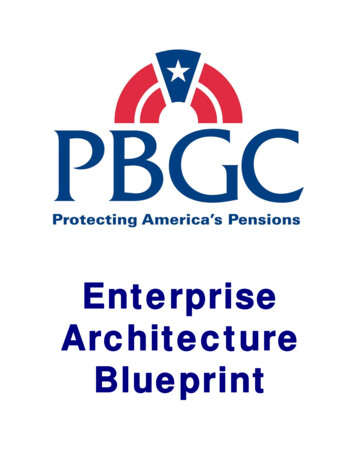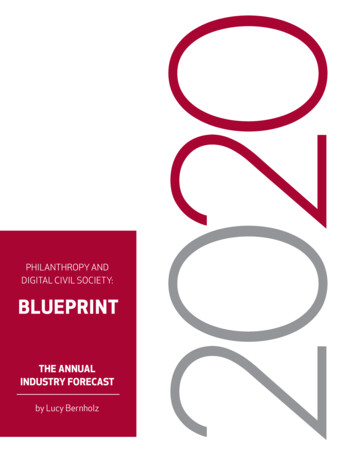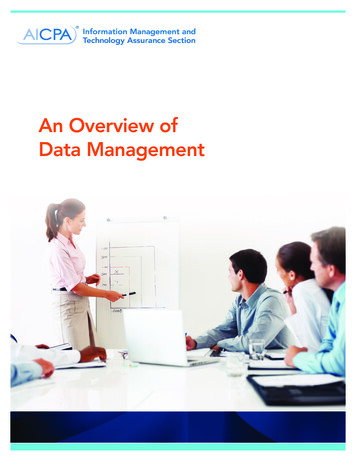
Transcription
EnterpriseArchitectureBlueprint
EA BlueprintPBGC Enterprise Architecture Executive SummaryPlans and specifications are needed to build anything complex. The same is true forapplications supporting PBGC’s strategic goals and demanding business needs. ThePBGC Enterprise Architecture Blueprint version 2.0 builds on past standards andinitiatives and continues to add the standards necessary to achieve our target architecture.This blueprint promotes solutions that focus IT efforts on meeting business needs andsupporting corporate goals. It describes the underlying framework, the shared services,and the standardized components that will be used to build the new architecture. Theblueprint defines the guiding principles and approach to development that lead to ourtarget architecture.The target architecture is business driven and highly integrated with strategic planningand customer and business needs. We are implementing a component-based architecturethat will allow PBGC to assemble applications from shared services within thecorporation and inter-agency sharing of common business functions when available.The architecture is dynamic, tied to both the business and the development communities.Members benefit from and contribute to it. To support the development of core servicesand new application, this blueprint primarily focuses on the details of the applicationdomain that are critical to system developers building services, components, andapplications.The Enterprise Architecture includes the processes, tools and information stores thatidentify the links between the business vision, the business processes, and IT. IT isfurther elaborated as Development, QA, Security, Application Integration,Data/Information, and Deployment architectures.This organization-wide EA framework and associated initiatives are cited in the PBGC’04-’08 Strategic Plan as a foundation for Cross Cutting Goal C3, “IT ManagementStrategies.” This supports PBGC lines of business, cost-efficiency goals, and thePresident’s Management Agenda. The EA also addresses important OMB 300requirements.The EA is only one overall governing structure supporting the IT part of the solutions.With SLCM activities, Solutions Delivery, and Infrastructure Planning, Engineering,Administration, and Operations, OIT efforts will align best with PBGC business goalsand achieve optimal efficiency and effectiveness.Section 1: Introduction and Overview
EA Blueprint1.Introduction and Overview Section1.1The EA ProgramPBGC spends 70 million annually for IT investments, including new systems,maintenance and infrastructure support. Are these resources well invested andgetting a good return on investment (ROI)? Enterprise Architecture (EA) is partof the framework that enables decision makers to have confidence that the answerto this question is yes.EA is several things. It is an organizational element in OIT. It is the programcarried forward by that organization and others. It is various products deliveredby that program, such as the EA roadmap and the EA blueprint and the target EA.1.1.1PurposeThe purpose of the EA program is to ensure that IT solutions and investmentsalign with and support the business goals of the corporation and successfully meetbusiness needs for which they are designed. The PBGC strategic plan is thedriver, identifying the corporation’s mission, vision, and values, at which ITinvestments must aim.1.1.2GoalsOIT has developed several IT goals that comprise a mechanism to measure howproposed IT solutions fit (or do not fit) within the EA of PBGC. These goals areused to evaluate compliance and provide the EA staff with the necessary standardto provide guidance and feedback on IT investments. These goals are that ITinvestments: 1.1.3Must be able to demonstrate alignment with the business strategy and needs ofthe corporationShould be interoperable with the corporation’s systems and servicesDeliver high end-user satisfactionShould be designed in and open systems environmentEnable public access to required information in an efficient and affectivemannerEnsure compliance to pertinent federal and corporation laws, regulation,policies, and guidelinesGuidelinesPBGC’s EA follows a basic set of guidelines: Simpler is better. Supporting several different vendors’ products providingthe same functionality increases costs unnecessarily.Commercial products should be used where possible. In general it is more costeffective to use a commercial product so that the cost of innovation is spreadacross multiple companies.Industry based standards or best practices or should be used when available.The use of industry standards increases the robustness of the standard andSection 1: Introduction and Overview
EA Blueprint 1.1.4reduces time and costs for PBGC to adopt that standard. (NIST, World WideWeb Consortium (W3C), Java Community)The architectural design must consider and address the needs of the entireCorporation.The architectural design must be modular and extensible allowing for newtechnologies and configurations to be deployed with minimal costs andimpact.Build it once. Don’t reinvent functionality. Common needs should be met byconstructing and using common services.There is a single source for enterprise data. Data integrity is maintained byallowing only a single component to operate on specific data.BenefitsThe EA uses the PBGC strategic plan to identify how IT investments align andsupport the corporation’s mission, vision, and values. The EA provides oversightvia reviews of business cases and technical documents to ensure that ITinvestments and solution delivery remain aligned with their business drivers.Other benefits that an EA program provides to PBGC include developing anddocumenting a roadmap that sets standards and guidelines for future IT solutionsdevelopment. Also, EA fosters the development of common IT services and reuseof IT resources to maximize the ROI of the corporation’s investments. An EAprogram also promotes interoperability of IT systems and solutions. And finally,the corporation is required to develop and implement an EA program throughFederal laws, policies, and guidelines.1.1.5EA BlueprintThe EA blueprint is a set of documents and information presented in the corporateportal that explains the PBGC target Enterprise Architecture. It provides moredetail than the previously published EA roadmap. It is intended to guidedevelopers of PBGC applications to ensure that their efforts hit the targetsestablished in the business process, data, applications and infrastructurearchitecture domains. It provides a set of standards based on industry bestpractices and technical solutions that meet the goals of the EA, provide anoptimum ROI, and allow the corporation to transition to the target architecture.The PBGC EA is a framework developed around the implementation of ITstandards and processes. The EA staff is responsible for the development andpublication of these standards.The IT world is in constant flux as new technologies, products, and solutions aredeveloped and introduced. The EA blueprint adapts to these changes in acontrolled way. It guides IT investment to realize the benefits of improvedtechnology and best practices when they can have a positive impact on ROI. TheEA blueprint is a living document, responsive to market and organizationalchanges. See the EA Program and Processes Section for information about theprocesses by which EA blueprint is managed and maintained.Section 1: Introduction and Overview
EA BlueprintThe PBGC target architecture is a services oriented architecture (SOA). Thisarchitecture fosters the development of common IT services and reuse of ITresources to maximize the ROI of the corporation’s investments. It also promotesinteroperability of IT systems and solutions, reducing the investment required forPBGC business to work together collaboratively and efficiently. The CommonServices Section of the blueprint provides additional description of the SOA andhow it is implemented in PBGC. Technical standards covering the SOA arefound in the Applications Domain Section and the Infrastructure Domain Sectionof the blueprint.1.2Organization of the Blueprint as a WholeThe EA blueprint is a set of documents and information presented in the EABlueprint Publication on the corporate portal. There are diagrams, textdocuments and databases, open to browse, with a search function, and withnumerous built in internal links for navigational convenience. It also containslinks to other documents or to other sites where relevant information is found. Aselection of the information on the portal, unified into a single PDF document, isavailable on the portal and on the intranet and may sometimes be put on slides forpresentation or printed for paper distribution. However, as it is a living document,the portal is the preferred means of access.The sections of the blueprint (found in document sub-folders on the portal) are:Section(This section)Information Found In That SectionGeneral description of the EA blueprint document; its structure, andscope, target audience and applicability; how to navigate, and linksto other sections. The paragraphs below provide additionalinformation about this section.2. EA Programand ProcessesSectionDescribes processes for maintaining the EA blueprint: how tosuggest changes; how to request exceptions; and how to get answersto questions.3. BusinessProcess DomainSectionDescribes an architectural framework identifying, grouping andorganizing PBGC processes. Includes the PBGC business structureand references EA standards for defining, modeling, anddocumenting business processes, and tools supporting processmodeling.4. Data DomainSectionDescribes the life cycle of data including acquisition, cleansing,transactional, through reporting and analytics. Concepts are shownincluding the separation of data based on the function operating onthe data.5. ApplicationsDomain SectionDescribes in detail PBGC’s services oriented architecture along withthe deployment model using Java and Oracle’s application server.6. InfrastructureDomain SectionDescribes the technology infrastructure required to support theapplications that are developed to meet the business needs of PBGCas well as the core network services (e.g. E-mail, Internet access,1. Introductionand OverviewSectionSection 1: Introduction and Overview
EA BlueprintLAN/WAN, cable plant, network protocols, data storage and backup,etc) needed to provide connectivity to internal and externalcustomers of the corporation’s IT services and resources.7. CommonServices SectionThe PBGC target architecture is Services Oriented Architecture(SOA). This section of the EA Blueprint describes commonservices, with a particular focus on information that crossesarchitecture domain boundaries (e.g., between applications andinfrastructure domains). It provides a brief explanation of what anSOA is, defines categories of common services, provides lists anddefinitions of services in each category, identifies common servicedevelopment and deployment standards, and presents links to currentcommon services development projects and repositories of availablecommon services.8. Tools andRepositoriesSectionEach architecture domain is supported by a set of tools and processesappropriate to the domain. Information relevant to a domain, createdor maintained by the tools or processes, is stored in a set of datarepositories. This section of the EA Blueprint describes some ofthese tools, processes and repositories. The tools, processes andrepositories specified are thereby established as standards for PBGCuse.This section describes what part of the document has not beencompleted and future plans for the document.9. Blueprint Gapsand Future Plans1.3Organization of the Introduction and Summary SectionThe information in this section is captured in various formats as appropriate to thetype of information (such as PDF files, Excel spreadsheets, Word documents,PowerPoint slides, portlets and URL references). The complete set of presentationelements can be reached on the portalThe information in this section is organized and presented as follows:Item/LinkEA exec se Architecture Executive Summary. A brief summaryof the purpose, value and content of the EA blueprint.Introduction Section (this document). Text document describingthe Introduction Section of the PBGC EA Blueprint, including theorganization of the blueprint as a whole.EnterpriseArchitectureGlossary.docEnterprise Architecture Glossary. A list of selected terms andacronyms, with definitions, provided as a reference to aid inunderstanding unfamiliar areas.EnterpriseArchitectureDomain Model.pdfEnterprise Architecture Domain Model. A graphic and textdescription of the domain model which provides the basic structureof the Enterprise Architecture.Section 1: Introduction and Overview
EA Blueprint1.4EnterpriseArchitectureGraphic View.pdfEnterprise Architecture Graphic View. A graphicalrepresentation of some of the elements of the PBGC EnterpriseArchitecture, with links. See section 1.6 below for moreinformation.EA DetailedStandards.docEA Detailed Standards. This blueprint specifies numerousstandards in the graphic and text documents. Selected standardshave been elaborated in additional stand-alone documentsdescribing them in greater detail. This document lists and provideslinks to the additional detailed documents for those selectedstandards.(future)Frequently Asked Questions. Access to questions previouslyasked and answers provided concerning the EA blueprint.Enterprise Architecture Domain ModelA key to understanding the corporation’s EA framework is the Domain Model, whichstructures the target architecture. The Domain Model is comprised of six distinctdomains, or parts, that are interrelated, and, together, show the progression ofbusiness and strategic needs driving IT solutions. The various EA architecturecomponents are organized around these domains.The Domain Model has six domains, described briefly in the following table. Agraphic view and additional explanation of the domain model is found in thedocument Enterprise Architecture Domain Model.pdf in the introduction section ofthe blueprint. The architecture and standards applicable to each domain are found inthe corresponding sections of the blueprint (links in the table below).DomainBusinessProcessesDataSkills andOrganizationApplicationsDescriptionThe Business Process Domain describes the EA from the point ofview of the business requirements, which are derived from strategicplans and business goals. This section describes the architecturestandards for business process analysis.The Data Domain describes the EA from the point of view of the data,which are inputs to and outputs from the Business Model. Architecturestandards in this section cover naming conventions and structuring toensure consistent shared data across the organization.The Skills and Organization Domain describes the work andactivities needed to perform and control business processes that theCorporation needs. Business processes determine the skills andorganization needed . Enterprise architecture models and standardshave not yet been developed for this domain.The Applications Domain describes the flow of activitiesencompassed by business processes. Business processes alsodetermine what must be done to the data by applications. .Architectures in this section are the most fully developed and providestandards and guidance for the developers to ensure interoperableSection 1: Introduction and Overview
EA ications built with minimum redundancy and maximum re-use.The Technology Infrastructure Domain describes how, applicationsand data requirements drive the technology infrastructure that providesthe platforms on which databases and applications run. Architecturesin this section provide standards and direction for the infrastructure.The Facility Domain describes facility requirements for housing theorganization and infrastructure based on business processes.Enterprise architecture models and standards have not yet beendeveloped for this domain.Enterprise Architecture Graphic ViewFigure 1-2 depicts at a high level the relationship of Enterprise Architecture to itsbusiness drivers and also the major elements of the Enterprise Architecture.Section 1: Introduction and Overview
EA BlueprintEnterprise sGoals1.2) Business ortRepositoriesPensionInsurance1.3) IT ApplicationIntegrationCommon ServicesInformationDataApplicationPBGC GoalsGoal 1 - Protect existing benefit plans and theirparticipants, and thereby encourage new plans.Goal 2 - Provide high-quality, responsive servicesand accurate and timely payment of benefits toparticipants.Goal 3 - Strengthen financial programs and systemsto keep the pension insurance system solvent.Goal 4 - Improve internal management supportoperations.InfrastructureGOAL: Encourage a stable, adequatelyfunded system of private pension plans.Key Performance Indicators:Stable and Solvent Insurance SystemEarly WarningInvestment ManagementPractitioner Servicese-Gov for PractitionersFigure 1-1: Enterprise Architecture Graphic ViewSection 1: Introduction and OverviewToolsBusinessStrategy &RulesQuality AssuranceService Deficiency ResolutionPerformance Monitoring and Reporting1.1) Business Vision:NetworkGOAL: Provide responsive, timely and accurateservices to participants in trusteed plans.Key Performance Indicators:Timely benefit estimates to ParticipantsTimely Acknowledgement of ParticipantsContactsTimely and Accurate Benefit ProcessingTimely Appeals Processinge-Gov for participant/missing participants
EA BlueprintThere are three levels:The Business Vision (1.1) indicates that strategy and goals established in thecorporate business vision are the driving force which controls the architecture.Business Architecture (1.2) is derived from Business Vision. It shows the three linesof business (Pension Insurance, Plan Termination and Operational Support)established by the business vision for PBGC.IT Architecture (1.3) is implemented based on the design of the BusinessArchitecture.These and other elements depicted in the diagram are described in the paragraphsbelow:1.5.1Business VisionThe business vision of the EA framework represents the mission, vision, values, andgoals of PBGC as well as the Corporation’s strategic plan and the correspondingstrategic planning framework. This is also the EA layer where the business driversthat own IT investments are defined and derived from, usually in the form ofsupporting outcome goals and strategic initiatives.1.5.2Business ArchitectureThe business architecture layer of the EA framework represents the three businessareas of PBGC and includes 1) Pension Insurance, 2) Plan Termination, and 3)Operational Support. Included in this layer are the business processes and functionsthat each business area requires and owns to carry out the tasks and meet the goals ofthat area.1.5.3IT ArchitectureThe IT architecture of the EA framework represents the components that provide forthe development, implementation, and management the IT investments. Within eachof these elements are found the technical solutions and standards required to developsystems and services within the PBGC EA framework.Inside the IT Architecture block several elements are identified. Each of theseelements is also a hyperlink to another page of the graphic where those elements arepresented in greater detail. The architecture elements depicted in this block aresecurity, application, integration, service, information, deployment, andinfrastructure. Another block to the side depicts supporting elements, which areprocesses, tools, repositories and artifact relationships.1.6 FrequentlyAskedQuestionsIn the future, a repository of questions asked and answered will be exposed here. Atthis time, no questions have been raised, nor has it been determined what repositorytype will store and display this information. When questions are raised in the future,they will be answered, captured, and exposed on the EA Blueprint portal.Section 1: Introduction and Overview
EA Blueprint1.7EA Detailed StandardsThis section lists and provides links to the additional detailed documents for thosestandards which have been selected for detailed explanations. The EA blueprintspecifies numerous standards in the graphic and text documents. For instance, asshown in Figure 1-1, the Applications Architecture diagram in the EnterpriseArchitecture Graphic View indicates that our standard Model-View-Controller(MVC) implementation is Struts 2.0.Figure 1-2: Selection from Applications Architecture diagram, showing MVC in themiddleWhile this is a standard, it is clear from Figure 1-1 that there is not a lot ofinformation provided about this standard. Therefore, selected standards have beenelaborated in additional stand-alone documents describing them in greater detail. Forinstance, the document “Standards Profile - Presentation Layer - Architecture.doc”was prepared in April 2003, describes the MVC (model-view-controller) architecture,and provides the rationale as to why this standard was selected. Figure 1-2 shows justthe introduction; click the link above to read the entire document.Profile InformationTitle:Number:RevisionNumber:Origin Date:Revision Date:Revision Status:TRM Location:Presentation Layer– Software Architecture1.001 APRIL 200330 APRIL 2003FinalPresentation LayerDescription: This SP deals with the software architecture recommendations for theSection 1: Introduction and Overview
EA Blueprintpresentation layerFigure 1-3: Introductory information from the Standards Profile - Presentation Layer Architecture.doc1.7.1A Standard is still a Standard, Even if it is not a Detailed StandardMost of the standards which are depicted in the diagrams are described briefly in thetext document in each blueprint section, even if they have not been selected forfurther explanation in a detailed standard. For instance, figure 1-3 is taken from thetext document “Applications Domain Section.doc” describing the graphicpresentation of standards in the applications domain section. Struts, an MVC2 implementation - Struts is a set of cooperating classes, servlets,and JSP tags that make up a reusable MVC 2 design. This definition implies thatStruts is a framework, rather than a library, but Struts also contains an extensivetag library and utility classes that work independently of the framework.Figure 1-4: Selection from Applications Domain Section.docNote that items depicted in the diagrams, such as the “MVC: Struts 2.0” exampleabove, are EA standards. They are standards even if there is no further explanation inthe companion text document. They are standards even if there is no standalonedetailed standards document on the same topic.1.7.2 Detailed Standards List and LinksDetailed StandardSectionDescriptionBrowser SupportGuidelines for WebBasedApplications.docApplicationSpecifies browser version PBGC applications mustsupportLogical ModelMetadata andNamingStandards.docDataDefines the standards for logical data model namingand metadata for use by designers and developersPBGC CorporateNamingDataSpecifies naming standards for PBGC data elementsSection 1: Introduction and Overview
EA BlueprintStandards.docPBGC Intranet UserInterfaceGuidelines.docApplicationSpecifies standard set of views into PBGC data andcomponents that have the same look and feel forPBGC applicationsPBGC J2EE SessionManagementStandard.docApplicationStandard method that all PBGC J2EE web basedapplications will use when creating, managing anddestroying server maintained sessions of webapplicationsPBGC PhysicalModelStandards.docDataStandards for naming, and object abbreviationmethods for physical data models for designers anddevelopers at PBGCPBGC onInteraction standards for java archives, .netassemblies, and services at a URI and accessiblethrough SOAP or RMI interfacePBGC SoftwareConfigurationManagement Planfor Reuse.docApplicationEstablishes a reuse framework, including existingcomponent harvesting and re-packaging, assetidentification and certification for reuse, assetcertification requirements, component library andCM processPerformanceGuidelines for WebBasedApplications.docApplicationSpecifies expected performance (screen responsetime) for web-based applications at PBGCProcess ModelStandardProfile.docBusinessProcessSpecifies information on collecting informationabout PBGC business processes, and generalbusiness process analysis modeling metadata andstandardsPBGC BusinessProcess ModelingStandards.docBusinessProcessSpecifies standards and guidelines for businessprocess modeling conventions and metadata(descriptions and properties)Project ModelManagement.docDataSpecifies the process that controls and monitors thecreation, modification and deletion of data andprocess models and the interactions among thosemodelsBusinessProcessStandards Profile Presentation Layer- Architecture.docApplicationDescribes model-view-controller UI architecture andwhy it is selected for PBGC SOAStandards Profile Presentation Layer- PortalConcept.docApplicationDescribes target architecture for unifying PBGCworkers desktop in the portal as presentation UI ofSOASection 1: Introduction and Overview
EA BlueprintStandards Profile Presentation Layer- Technology.docApplicationSpecifies programming technology for custom UIdevelopmentStandards Profile SecurityArchitecture.docApplicationSpecifies application security architectureStandards Profile SystemDevelopment.docApplicationExecutive summary of established standards fortechnology stack1.8SupportThe person assigned to maintain this section is Kirby Sutton. You may ask questionsor make suggestions concerning this section to him at x6602 or by e-mail atsutton.kirby@pbgc.gov, or by contacting any Enterprise Architect. Also see theProgram and Process Section of the EA blueprint.Version1.0DateDescriptionon July xx, 2004 Initial release versionSection 1: Introduction and Overview
EA Blueprint2.Processes2.1IntroductionEA is several things. It is an organizational element in OIT. It is the program carriedforward by that organization and others. It is various products delivered by thatprogram, such as the EA roadmap and the EA blueprint and the target EA.This document describes in detail information, also shown in graphic view, ofselected processes which are part of the EA program. These processes are how theEA group and others (primarily OIT) create, maintain, and update standards and theEA blueprint.The EA blueprint and standards are applicable to the Process, Data, Applications andInfrastructure Domains.The information in this section is captured in various formats as appropriate to thetype of information (such as PDF files, Excel spreadsheets, Word documents,PowerPoint slides, portlets and URL references). The complete set of presentationelements can be reached on the portal.The information in this section is organized and presented as follows:Item/LinkDescriptionProgram andProcessesSection.docProgram and Processes Section: Text documentdescribing the Program and Processes Section of thePBGC EA Blueprint, including program goals andprocesses.StandardsImplementationPlan.docEA Standards Implementation Plan: This documentdescribes the 90 -day plan for implementing EAstandards.Training Plan.doc(future)2.2Frequently Asked Questions: Access to questionspreviously asked and answers provided concerning theEA blueprint.Overview of Standards and Blueprint Maintenance ProcessesThis section describes five processes: 2.32.42.52.62.7The Intake ProcessThe Moderate/Small Scope Blueprint or Standard Change ProcessThe Waiver from Standards Compliance ProcessThe Create Standard/Major Blueprint Change ProcessThe Question/Suggestion/Comment ProcessSection 2: Processes
EA Blueprint 2.42.52.62.7The Moderate/Small Scope Blueprint or Standard Change ProcessThe Waiver from Standards Compliance ProcessThe Create Standard/Major Blueprint Change ProcessThe Question/Suggestion/Comment ProcessThe intake process is the common start point of all four of the remaining processes.Part of the intake process is an evaluation of the incoming item to determine which ofthe other four processes should be applied.Additional processes to be drafted are listed in section 2.8 Pending2.3The Intake Process2.3.1TriggersEdits.All processes begin with an external trigger. The intake process records the externaltrigger and starts the appropriate process. The external trigger may occur with an EAarchitect or with someone else.Triggers that may occur with an EA architect include: Recognition that the PBGC strategic plan implies a change is needed in theblueprint/standardsRecognition that a technology or best practice seen may be beneficial to PBGCRecognition of an error or omission or clarification needed in theblueprint/standards (based on own review or based on seeing patterns in questionsreceived)Triggers that may occur with someone else include: Confusion about, question on, or suggestion for content or presentation ofblueprint/standardsMotivation not to comply with a standardDesire to use a technology or practice which may be beneficial to a projectTriggers originating outside of EA may often originate with an OIT manager, projectmanager, or infrastructure support, or with contractors and business area staff andmanagement.2.3.2Portal FormIt will be mandatory for OIT employees and contractors to use the portal form to startthe intake process.Some business unit employees, such as those who meet regularly with OIT customerfacing units, may be given access to the portal form. Should these business unitemployees wish to initiate an item, they may do
Enterprise Architecture Domain Model.pdf . Enterprise Architecture Domain Model. A graphic and text description of the domain model which provides the basic structure of the Enterprise Architecture. Section 1: Introduction and Overview . EA Blueprint. Enterprise .File Size: 2MB










